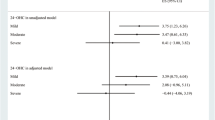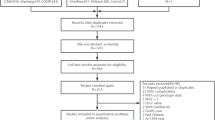Abstract
Like the apolipoprotein E (APOE) gene, the most common genetic determinant for Alzheimer’s disease (AD), the cholesteryl ester transfer protein (CETP) is involved in lipid metabolism. We studied the I405V polymorphism of the CETP gene in relation to AD. We genotyped 544 AD cases and 5,404 controls from the Rotterdam study, using a TaqMan allelic discrimination assay. Odds ratios (ORs) for AD were estimated using logistic regression analysis. CETP VV carriers showed significantly increased high-density lipoprotein levels compared to the IV and II carriers. In the overall analysis of AD, the risk of disease for the VV carriers of the CETP polymorphism was non-significantly increased compared to II carriers ORVV = 1.33, 95% confidence interval (CI) 0.96–1.90 p = 0.08). In those without the APOE*4 allele, the risk of AD for VV carriers was increased 1.67-fold (95% CI 1.11–2.52, p = 0.01). The difference in the relationship between CETP and AD between APOE*4 carriers and APOE*4 non-carriers was statistically significant (p for interaction = 0.04). Our results suggest that the VV genotype of the I405V polymorphism of the CETP gene increases the risk of AD in the absence of the APOE*4 allele, probably through a cholesterol metabolism pathway in the brain.
Similar content being viewed by others
References
Mahley RW, Weisgraber KH, Huang Y (2006) Apolipoprotein E4: a causative factor and therapeutic target in neuropathology, including Alzheimer’s disease. Proc Natl Acad Sci USA 103(15):5644–5651
Yanagisawa K, Matsuzaki K (2002) Cholesterol-dependent aggregation of amyloid beta-protein. Ann N Y Acad Sci 977:384–386
Yanagisawa K (2002) Cholesterol and pathological processes in Alzheimer’s disease. J Neurosci Res 70(3):361–366
Puglielli L, Tanzi RE, Kovacs DM (2003) Alzheimer’s disease: the cholesterol connection. Nat Neurosci 6(4):345–351
Michikawa M (2003) The role of cholesterol in pathogenesis of Alzheimer’s disease: dual metabolic interaction between amyloid beta-protein and cholesterol. Mol Neurobiol 27(1):1–12
Michikawa M (2004) Neurodegenerative disorders and cholesterol. Curr Alzheimer Res 1(4):271–275
Abad-Rodriguez J, Ledesma MD, Craessaerts K, Perga S, Medina M, Delacourte A, Dingwall C, De Strooper B, Dotti CG (2004) Neuronal membrane cholesterol loss enhances amyloid peptide generation. J Cell Biol 167(5):953–960
Wolozin B, Kellman W, Ruosseau P, Celesia GG, Siegel G (2000) Decreased prevalence of Alzheimer disease associated with 3-hydroxy-3-methyglutaryl coenzyme a reductase inhibitors. Arch Neurol 57(10):1439–1443
Simons M, Keller P, Dichgans J, Schulz JB (2001) Cholesterol and Alzheimer’s disease: is there a link? Neurology 57(6):1089–1093
Mauch DH, Nagler K, Schumacher S, Goritz C, Muller EC, Otto A, Pfrieger FW (2001) Cns synaptogenesis promoted by glia-derived cholesterol. Science 294(5545):1354–1357
Fan QW, Yu W, Senda T, Yanagisawa K, Michikawa M (2001) Cholesterol-dependent modulation of tau phosphorylation in cultured neurons. J Neurochem 76(2):391–400
Reiss AB (2005) Cholesterol and apolipoprotein E in Alzheimer’s disease. Am J Alzheimers Dis Other Dement 20(2):91–96
Hersberger M, von Eckardstein A (2005) Modulation of high-density lipoprotein cholesterol metabolism and reverse cholesterol transport. Handb Exp Pharmacol (170):537–561
Barter PJ, Kastelein JJ (2006) Targeting cholesteryl ester transfer protein for the prevention and management of cardiovascular disease. J Am Coll Cardiol 47(3):492–499
Blankenberg S, Rupprecht HJ, Bickel C, Jiang XC, Poirier O, Lackner KJ, Meyer J, Cambien F, Tiret L (2003) Common genetic variation of the cholesteryl ester transfer protein gene strongly predicts future cardiovascular death in patients with coronary artery disease. J Am Coll Cardiol 41(11):1983–1989
Atzmon G, Rincon M, Rabizadeh P, Barzilai N (2005) Biological evidence for inheritance of exceptional longevity. Mech Ageing Dev 126(2):341–345
Rodriguez E, Mateo I, Infante J, Llorca J, Berciano J, Combarros O (2006) Cholesteryl Ester Transfer Protein (Cetp) polymorphism modifies the Alzheimer’s disease risk associated with Apoe Epsilon4 Allele. J Neurol 253(2):181–185
Zhu H, Gopalraj RK, Kelly JF, Bennett DA, Estus S (2005) Lack of genetic association of cholesteryl ester transfer protein polymorphisms with late onset Alzheimer’s disease. Neurosci Lett 381(1–2):36–41
Hofman A, Grobbee DE, de Jong PT, van den Ouweland FA (1991) Determinants of disease and disability in the elderly: the Rotterdam elderly study. Eur J Epidemiol 7(4):403–422
Vermeer SE, Prins ND, den Heijer T, Hofman A, Koudstaal PJ, Breteler MM (2003) Silent brain infarcts and the risk of dementia and cognitive decline. N Engl J Med 348(13):1215–1222
Barendregt JJ, Ott A (2005) Consistency of epidemiologic estimates. Eur J Epidemiol 20(10):827–832
Folstein MF, Folstein SE, McHugh PR (1975) “Mini-Mental State”. A practical method for grading the cognitive state of patients for the clinician. J Psychiatr Res 12(3):189–198
Copeland JR, Kelleher MJ, Kellett JM, Gourlay AJ, Gurland BJ, Fleiss JL, Sharpe L (1976) A semi-structured clinical interview for the assessment of diagnosis and mental state in the elderly: the geriatric mental state schedule. I. Development and reliability. Psychol Med 6(3):439–449
American Psychiatry Association (1987) Diagnostic and statistical manual of mental disorders
McKhann G, Drachman D, Folstein M, Katzman R, Price D, Stadlan EM (1984) Clinical diagnosis of Alzheimer’s disease: report of the NINCDS-ADRDA work group under the auspices of department of health and human services task force on Alzheimer’s disease. Neurology 34(7):939–944
Miller SA, Dykes DD, Polesky HF (1988) A simple salting out procedure for extracting DNA from human nucleated cells. Nucleic Acids Res 16(3):1215
Wenham PR, Price WH, Blandell G (1991) Apolipoprotein E genotyping by one-stage Pcr. Lancet 337(8750):1158–1159
Yamada T, Kawata M, Arai H, Fukasawa M, Inoue K, Sato T (1995) Astroglial localization of cholesteryl ester transfer protein in normal and Alzheimer’s disease brain tissues. Acta Neuropathol (Berl) 90(6):633–636
(2005) A Haplotype Map of the Human Genome. Nature 437(7063):1299–1320
Fidani L, Goulas A, Crook R, Petersen RC, Tangalos E, Kotsis A, Hardy J (2004) An association study of the cholesteryl ester transfer protein taqi B polymorphism with late onset Alzheimer’s disease. Neurosci Lett 357(2):152–154
Jiang XC, Zhou HW (2006) Plasma lipid transfer proteins. Curr Opin Lipidol 17(3):302–308
Bjorkhem I, Meaney S (2004) Brain cholesterol: long secret life behind a barrier. Arterioscler Thromb Vasc Biol 24(5):806–815
Vance JE, Hayashi H, Karten B (2005) Cholesterol homeostasis in neurons and glial cells. Semin Cell Dev Biol 16(2):193–212
Jurevics H, Morell P (1995) Cholesterol for synthesis of myelin is made locally, not imported into brain. J Neurochem 64(2):895–901
Carter CJ, Mahley RW, Huang Y, Weisgraber KH (2007) Convergence of genes implicated in Alzheimer’s disease on the cerebral cholesterol shuttle: app, cholesterol, lipoproteins, and atherosclerosis putting cholesterol in its place: apoe and reverse cholesterol transport. Neurochem Int 50(1):12–38
Mahley RW, Huang Y, Weisgraber KH (2006) Putting cholesterol in its place: apoe and reverse cholesterol transport. J Clin Invest 116(5):1226–1229
Acknowledgement
A. Arias-Vasquez is supported by a grant from the Centre of Medical Systems Biology, grant no. 297-2003 and the Hersenstichting Nederland. The Rotterdam study is supported by the Erasmus Medical Center and Erasmus University Rotterdam, the Netherlands Organization for Scientific Research (NWO), the Netherlands Organization for Health Research and Development (ZonMw), the Research Institute for Diseases in the Elderly (RIDE), the Ministry of Education, Culture and Science, the Ministry of Health, Welfare and Sports, the European Commission (DG XII), and the Municipality of Rotterdam. The contributions of the general practitioners and pharmacists of the Ommoord district are greatly acknowledged. The authors declare no conflict of interest.
Author information
Authors and Affiliations
Corresponding author
Rights and permissions
About this article
Cite this article
Arias-Vásquez, A., Isaacs, A., Aulchenko, Y.S. et al. The cholesteryl ester transfer protein (CETP) gene and the risk of Alzheimer’s disease. Neurogenetics 8, 189–193 (2007). https://doi.org/10.1007/s10048-007-0089-x
Received:
Accepted:
Published:
Issue Date:
DOI: https://doi.org/10.1007/s10048-007-0089-x




